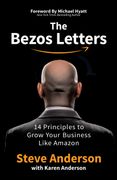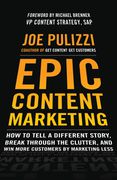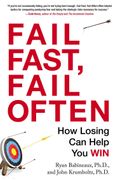
A 5 Minute Overview Of
The Bezos Letters
14 Principles to Grow Your Business Like Amazon
About the Author
Steve Anderson is a professional speaker, consultant, and futurist. He gives keynote presentations on the future of technology, how businesses can leverage the online world, and how companies can assess and use strategic risk to their advantage. His insurance agency, The Anderson Network, is considered to be a leader in the field of insuring productivity, technology, and profits. He is on the advisory boards of several insurance industry work groups and think-tanks. He is a graduate of the University of the District of Columbia and Taylor University.
The Main Idea
Amazon is the fasted company in history to reach $100 billion in sales! How did Jeff Bezos achieve that? The reality is Bezos leverages risk and has created an exceptional culture of experimentation and invention. He believes you don't grow if you're not willing to take risks, and he constantly evaluates Amazon's "RoR" — Return on Risk.
Fortunately for everyone else, Jeff Bezos has detailed and outlined his approach to risk and his growth strategies in his annual letters to Amazon's shareholders. Amazon has written these letters for the last twenty-one years. When you analyze them, it becomes clear there are fourteen growth principles which articulate how Bezos and Amazon use risk to their advantage.
These fourteen principles fall into four growth cycles:

Yes, every business takes risks, but haphazard risk-taking is like rolling the dice. You never know what's going to come up. But Bezos takes risks with intentionality, which most businesses, if aware, can also harness to achieve greater results. I believe what has fueled Amazon's growth comes down to Jeff Bezos' unique approach to taking and leveraging risk and his commitment to creating a culture for experimentation and invention. And it's all based on his views on success and, actually, failure.
How to Excel like Amazon
1. Test. At Amazon, testing is a way of life. All team members are encouraged to try new things and see whether they improve the way Amazon does business. If something doesn't work, there are no punishments but if something does work, Amazon bets big. Most businesses try and avoid failures, but Bezos does the exact opposite.
2. Build. At Amazon, building is how you turn promising ideas into stable initiatives. They build to make sure what they invest in is something customers actually want. Amazon is always willing to sacrifice short-term gains in order to build a strong foundation for new products which will be around for many years.
3. Accelerate. To Amazon, accelerating is what you do once something has been tested and shown to work. You then figure out how you can creatively use technology to boost what you're doing. You also form a passionate team to drive and accelerate the future growth, making your company fast-paced and dynamic.
4. Scale. For Amazon, scale requires that you maintain an innovative culture which is willing to take risks on behalf of the customer. You have to focus on maintaining high standards, measuring only what matters, and most important of all make decisions as if it is your first day in business. You have to focus on the customer.
Summaries.Com Editor's Comments
I really liked this book. There are serveral books that analyze Warren Buffett's letters to Berkshire Hathaway shareholders for clues into his approach to investing, but this is the first book I've seen that does the same for Jeff Bezos's letters to Amazon's shareholders.
The author, Steve Anderson, stresses that Bezos tries new things and is prepared to take risks. Bezos stated publicly that he is prepared to lose a billion dollars in order to figure out how to make billions more. You've got to admit that pretty gutsy!
The 14 principles that Steve Anderson distilled from those letters to shareholders are interesting in their own right. Obsessing over customers comes through loud-and-clear and so too does making high-velocity decisions. I particularly like the mindset of always acting like it's Day 1 and there's still unlimited opportunities that lie ahead. That's a great way to think and act.
Jeff Bezos borrowed $300,000 and quit his job to start the Amazon.com online book store in July 1994. That investment has grown like a rocket ship as Amazon has become the fastest company ever to reach $100 billion in sales, one of the first companies ever to be valued at $1 trillion, and the employer of more than 650,000 people (which is a number greater than the population of countries like Iceland and the Bahamas). That all suggests there might be something good in these principles.
Want in-depth 30-minute summaries?
In addition to this 5-minute overview, Summaries.Com has a premium 30-minute summary of this book and 1,000+ more, to help you advance your career and business.
Check Out Summaries.com Premium Plans Today!Want more 5-minute Snapshots?
To get a new 5-minute business book snapshot each week, sign up for the Summaries.com free plan.
Sign Up for the Summaries.com Free PlanThe Amazon Way of Business Collection
If you enjoyed this summary, here is a collection of related business book summaries, to help you get ideas and strategies that will give you an edge over your competition.
This course will teach what Amazon.Com does to grow and excel.
Buy The Amazon Way of Business Collection (5 x 30-Min Summaries)
The Bezos Letters
14 Principles to Grow Your Business Like Amazon
by Steve Anderson

Amazon.com: Get Big Fast
Inside the Revolutionary Business Model That Changed the World
by Robert Spector

The Amazon Way
14 Leadership Principles Behind the World's Most Disruptive Company
by John Rossman

Fail Fast, Fail Often
How Losing Can Help You WIN
by Ryan Babineaux and John Krumboltz

New Rules for the New Economy
10 Radical Strategies For a Connected World
by Kevin Kelly